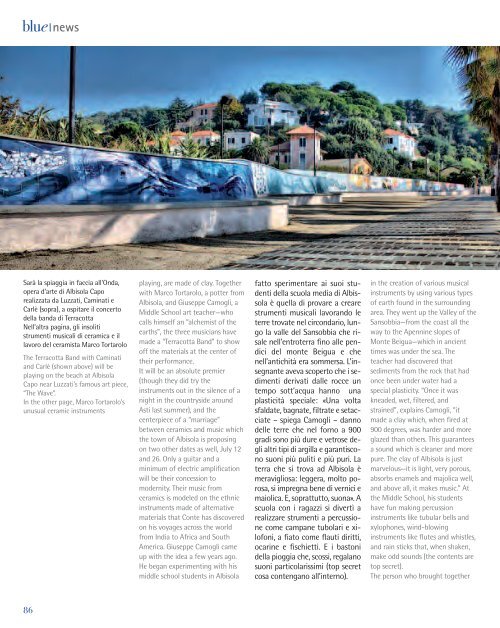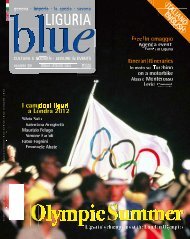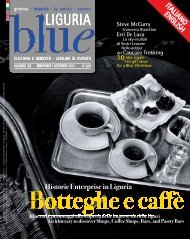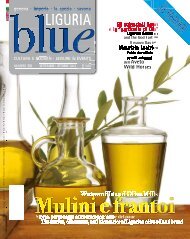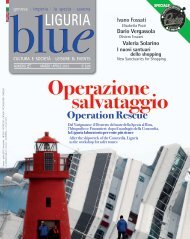Facciamoci sorprendere - Blue Liguria - Sagep
Facciamoci sorprendere - Blue Liguria - Sagep
Facciamoci sorprendere - Blue Liguria - Sagep
You also want an ePaper? Increase the reach of your titles
YUMPU automatically turns print PDFs into web optimized ePapers that Google loves.
lue<br />
news<br />
Sarà la spiaggia in faccia all'Onda,<br />
opera d’arte di Albisola Capo<br />
realizzata da Luzzati, Caminati e<br />
Carlè (sopra), a ospitare il concerto<br />
della banda di Terracotta<br />
Nell’altra pagina, gli insoliti<br />
strumenti musicali di ceramica e il<br />
lavoro del ceramista Marco Tortarolo<br />
The Terracotta Band with Caminati<br />
and Carlè (shown above) will be<br />
playing on the beach at Albisola<br />
Capo near Luzzati’s famous art piece,<br />
“The Wave”.<br />
In the other page, Marco Tortarolo’s<br />
unusual ceramic instruments<br />
86<br />
playing, are made of clay. Together<br />
with Marco Tortarolo, a potter from<br />
Albisola, and Giuseppe Camogli, a<br />
Middle School art teacher—who<br />
calls himself an “alchemist of the<br />
earths”, the three musicians have<br />
made a “Terracotta Band” to show<br />
off the materials at the center of<br />
their performance.<br />
It will be an absolute premier<br />
(though they did try the<br />
instruments out in the silence of a<br />
night in the countryside around<br />
Asti last summer), and the<br />
centerpiece of a “marriage”<br />
between ceramics and music which<br />
the town of Albisola is proposing<br />
on two other dates as well, July 12<br />
and 26. Only a guitar and a<br />
minimum of electric amplification<br />
will be their concession to<br />
modernity. Their music from<br />
ceramics is modeled on the ethnic<br />
instruments made of alternative<br />
materials that Conte has discovered<br />
on his voyages across the world<br />
from India to Africa and South<br />
America. Giuseppe Camogli came<br />
up with the idea a few years ago.<br />
He began experimenting with his<br />
middle school students in Albisola<br />
fatto sperimentare ai suoi studenti<br />
della scuola media di Albissola<br />
è quella di provare a creare<br />
strumenti musicali lavorando le<br />
terre trovate nel circondario, lungo<br />
la valle del Sansobbia che risale<br />
nell’entroterra fino alle pendici<br />
del monte Beigua e che<br />
nell’antichità era sommersa. L’insegnante<br />
aveva scoperto che i sedimenti<br />
derivati dalle rocce un<br />
tempo sott’acqua hanno una<br />
plasticità speciale: «Una volta<br />
sfaldate, bagnate, filtrate e setacciate<br />
– spiega Camogli – danno<br />
delle terre che nel forno a 900<br />
gradi sono più dure e vetrose degli<br />
altri tipi di argilla e garantiscono<br />
suoni più puliti e più puri. La<br />
terra che si trova ad Albisola è<br />
meravigliosa: leggera, molto porosa,<br />
si impregna bene di vernici e<br />
maiolica. E, soprattutto, suona». A<br />
scuola con i ragazzi si divertì a<br />
realizzare strumenti a percussione<br />
come campane tubolari e xilofoni,<br />
a fiato come flauti diritti,<br />
ocarine e fischietti. E i bastoni<br />
della pioggia che, scossi, regalano<br />
suoni particolarissimi (top secret<br />
cosa contengano all’interno).<br />
in the creation of various musical<br />
instruments by using various types<br />
of earth found in the surrounding<br />
area. They went up the Valley of the<br />
Sansobbia—from the coast all the<br />
way to the Apennine slopes of<br />
Monte Beigua—which in ancient<br />
times was under the sea. The<br />
teacher had discovered that<br />
sediments from the rock that had<br />
once been under water had a<br />
special plasticity. “Once it was<br />
kneaded, wet, filtered, and<br />
strained”, explains Camogli, “it<br />
made a clay which, when fired at<br />
900 degrees, was harder and more<br />
glazed than others. This guarantees<br />
a sound which is cleaner and more<br />
pure. The clay of Albisola is just<br />
marvelous—it is light, very porous,<br />
absorbs enamels and majolica well,<br />
and above all, it makes music.” At<br />
the Middle School, his students<br />
have fun making percussion<br />
instruments like tubular bells and<br />
xylophones, wind-blowing<br />
instruments like flutes and whistles,<br />
and rain sticks that, when shaken,<br />
make odd sounds (the contents are<br />
top secret).<br />
The person who brought together


